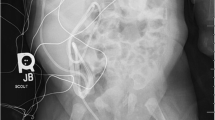Abstract
Background
Few standards exist for reporting results of voiding cystourethrogram (VCUG).
Objective
To assess the variation in reporting of VCUG findings from different facilities using a standardized assessment tool.
Materials and methods
VCUG reports were evaluated for demographic, technical, anatomical and functional information. Reports were categorized by age, gender, indication and vesicouretal reflux (VUR) status. Institutions were classified as a free-standing pediatric hospital (n = 3), pediatric hospital within a hospital (n = 11), or non-pediatric facility (n = 24) and reports were classified as having been read by a pediatric radiologist or not. Each category of outside reports (n = 152) was randomly matched with a twice-larger group of Hospital A reports from the same category (n = 304). Multivariate linear regression was used to analyze the association between the primary outcome (percentage of items described in dictated VCUG report) and the type of radiologist and institution.
Results
Of the 456 studies, 66% were in girls, 56% were in those <12 months old, and the indication was urinary tract infection (UTI) in 81%. The mean percentage of items reported was 67 ± 14% (74 ± 7% at free-standing pediatric hospitals, 61 ± 10% at pediatric hospitals within a hospital, and 48 ± 11% at non-pediatric facilities). In multivariate analysis, VCUG reports generated at non-pediatric facilities had 17% fewer items included (95% CI: 14.5–19.7%, P < 0.0001), and pediatric hospitals within a hospital had 9% fewer items included (5.9–12.5%, P < 0.0001) when compared to free-standing pediatric hospitals. Reports read by a pediatric radiologist had 12% more items included (9.1–15.3%, P < 0.0001) compared to those read by a non-pediatric radiologist.
Conclusion
More complete VCUG reports were observed when generated at free-standing pediatric hospitals and when interpreted by a pediatric radiologist.
Similar content being viewed by others
References
Houssami N, Boyages J, Stuart K et al (2007) Quality of breast imaging reports falls short of recommended standards. Breast 16:271–279
Lee R, Cohen MD, Jennings GS (2006) A new method of evaluating the quality of radiology reports. Acad Radiol 13:241–248
Schwartz LH, Panicek DM, Berk AR et al (2011) Improving communication of diagnostic radiology findings through structured reporting. Radiology 260:174–181
Le T, Fayadh RA, Menard C et al (2008) Variations in ultrasound reporting on patients referred for investigation of ovarian masses. J Obstet Gynaecol Can 30:902–906
Sistrom CL, Langlotz CP (2005) A framework for improving radiology reporting. J Am Coll Radiol 2:159–167
Bosmans JM, Weyler JJ, De Schepper AM et al (2011) The radiology report as seen by radiologists and referring clinicians: results of the COVER and ROVER surveys. Radiology 259:184–195
Meyer J (2012) Radiological Society of North America radiology reporting templates. http://www.radreport.org/template/0000110. Accessed 30 Sept 2013
Papadopoulou F, Efremidis SC, Oiconomou A et al (2002) Cyclic voiding cystourethrography: is vesicoureteral reflux missed with standard voiding cystourethrography? Eur Radiol 12:666–670
Children’s Hospital Association (2012) Find a children’s hospital link. http://www.childrenshospitals.net. Accessed 1 Oct 2012
American Board of Radiology (2014) Check board certification link. http://www.theabr.org. Accessed 30 Jan 2014
Frush DP, Donnelly LF, Rosen NS (2003) Computed tomography and radiation risks: what pediatric health care providers should know. Pediatrics 112:951–957
Knudson MJ, Austin JC, McMillan ZM et al (2007) Predictive factors of early spontaneous resolution in children with primary vesicoureteral reflux. J Urol 178:1684–1688
Barrett DM, Malek RS, Kelalis PP (1976) Observations on vesical diverticulum in childhood. J Urol 116:234–236
Arsanjani A, Alagiri M (2007) Identification of filling versus voiding reflux as predictor of clinical outcome. Urology 70:351–354
Estrada CR Jr, Passerotti CC, Graham DA et al (2009) Nomograms for predicting annual resolution rate of primary vesicoureteral reflux: results from 2,462 children. J Urol 182:1535–1541
Tynan A, Berenson RA, Christianson JB (2008) Health plans target advanced imaging services: cost, quality and safety concerns prompt renewed oversight. Issue Brief Cent Stud Health Syst Change 118:1–4
Andrews M (2012) Some Insurers Paying Patients Who Agree To Get Cheaper Care. Kaiser Health News. http://www.kaiserhealthnews.org/Features/Insuring-Your-Health/2012/Cash-Rewards-For-Cheaper-Care-Michelle-Andrews-032712.aspx. Accessed 15 Dec 2012
Goske MJ, Applegate KE, Bulas D et al (2011) Image gently: progress and challenges in CT education and advocacy. Pediatr Radiol 41:461–466
Sidhu M, Goske MJ, Connolly B et al (2010) Image Gently, Step Lightly: promoting radiation safety in pediatric interventional radiology. AJR Am J Roentgenol 195:299–301
Darling S, Sammer M, Chapman T et al (2011) Physician documentation of fluoroscopy time in voiding cystourethrography reports correlates with lower fluoroscopy times: a surrogate marker of patient radiation exposure. AJR Am J Roentgenol 196:777–780
Mayo E (1993) The human problems of an industrial civilization, vol 3, 2nd edn. MacMillan, New York
Paterson A, Frush DP, Donnelly LF (2001) Helical CT of the body: are settings adjusted for pediatric patients? AJR Am J Roentgenol 176:297–301
Hollingsworth C, Frush DP, Cross M et al (2003) Helical CT of the body: a survey of techniques used for pediatric patients. AJR Am J Roentgenol 180:401–406
Eakins C, Ellis WD, Pruthi S et al (2012) Second opinion interpretations by specialty radiologists at a pediatric hospital: rate of disagreement and clinical implications. AJR Am J Roentgenol 199:916–920
Gollub MJ, Panicek DM, Bach AM et al (1999) Clinical importance of reinterpretation of body CT scans obtained elsewhere in patients referred for care at a tertiary cancer center. Radiology 210:109–112
Sung JC, Sodickson A, Ledbetter S (2009) Outside CT imaging among emergency department transfer patients. J Am Coll Radiol 6:626–632
Loevner LA, Sonners AI, Schulman BJ et al (2002) Reinterpretation of cross-sectional images in patients with head and neck cancer in the setting of a multidisciplinary cancer center. AJNR Am J Neuroradiol 23:1622–1626
Conflicts of interest
None
Author information
Authors and Affiliations
Corresponding author
Appendix
Appendix
Form generated by Hospital A urologists and pediatric radiologists and used to systematically analyze all voiding cystourethrogram (VCUG) reports


Rights and permissions
About this article
Cite this article
Schaeffer, A.J., Sood, S., Logvinenko, T. et al. Variation in the documentation of findings in pediatric voiding cystourethrogram. Pediatr Radiol 44, 1548–1556 (2014). https://doi.org/10.1007/s00247-014-3028-7
Received:
Revised:
Accepted:
Published:
Issue Date:
DOI: https://doi.org/10.1007/s00247-014-3028-7




